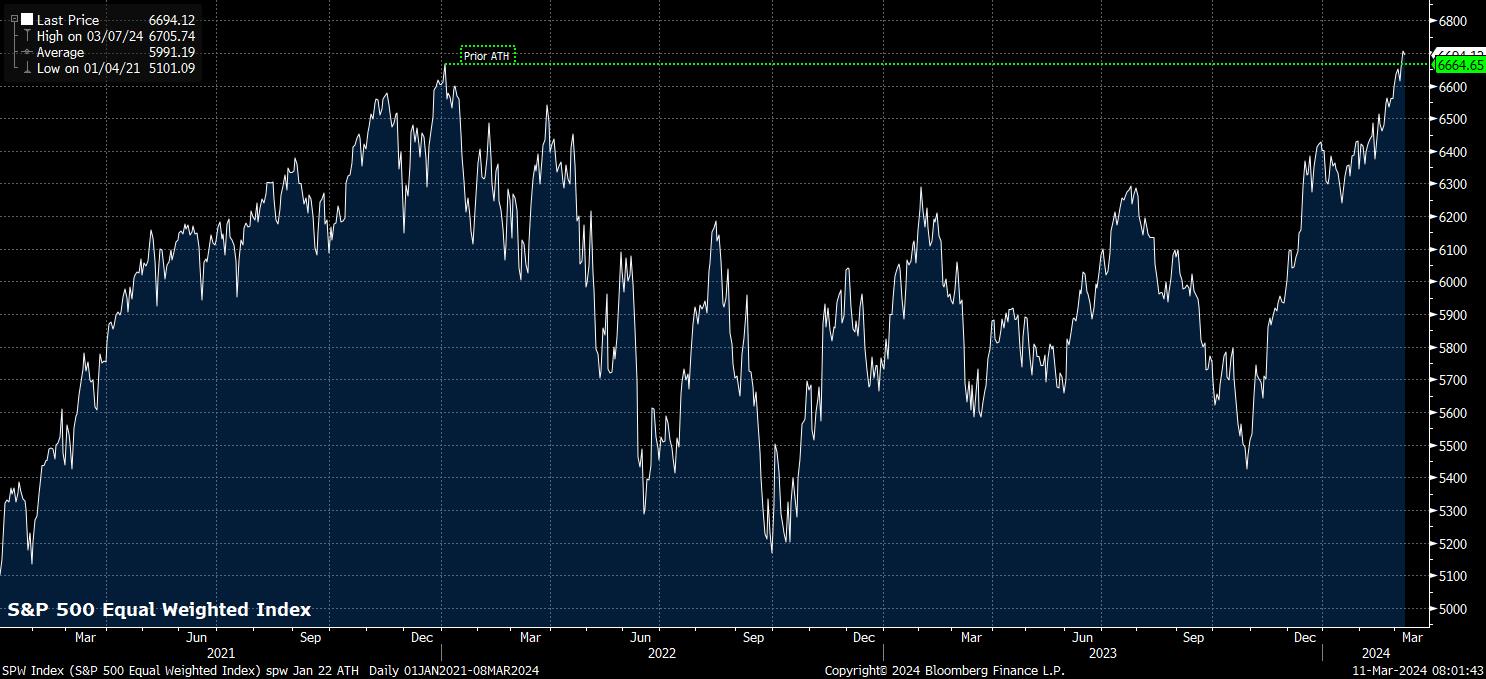差价合约(CFD)是复杂的工具,由于杠杆作用,存在快速亏损的高风险。80% 的散户投资者在于该提供商进行差价合约交易时账户亏损。 您应该考虑自己是否了解差价合约的原理,以及是否有承受资金损失的高风险的能力。
There are, however, some signs emerging that suggest this dynamic may be, slowly but surely, starting to shift, providing an increasingly supportive backdrop for equities at large.
Perhaps the most obvious of these can be found by glancing at the equal weighted S&P 500 index; simply, an index which contains the same 503 constituents as the conventional S&P 500, but assigns each the same weighting, as opposed to weighting index members according to their market cap. Last week, the equal weighted S&P 500 extended recent gains, rallying to a fresh record closing high for the first time in over two years, surpassing the prior all-time high set in January 2022.

Similar signs of equity gains broadening out are also evident elsewhere.
The ‘magnificent seven’ stocks, for example, are no longer all indiscriminately rallying with a near perfect correlation to each other, with stock- or sector-specific developments seemingly having a much greater impact this year, than they did last. Tesla, for instance, has slumped around 30% YTD amid worries over slumping EV demand, while Apple has also fallen substantially since the turn of the year, owing primarily to the deteriorating China sales outlook.
Meanwhile, Nvidia has continued to outperform, as the ‘picks and shovels’ play on the ongoing AI frenzy persists, while Meta has also continued to race higher amid thriving ad revenues.
_mag_7_2024-03-11_08-02-05.jpg)
Together, this all points to a substantially lower degree of speculative frenzy than some had feared might have been setting in last year. That fundamentals do still matter, and influence price, for each of these behemoths suggests that trading is of a much more considered nature than the ‘buy every MAG 7 stock’ mode that had appeared to be dominant in the minds of market participants last year. The lack of a speculative mania suggests that the risks of a ‘bubble’ are relatively low, and that there is likely room for further upside in the medium-term.
A look at the market more broadly suggests similar. Returning to the idea of breadth, as the rally has broadened out in recent months, just under 30% of S&P 500 constituents have hit a record high this year, even if industrials is the only sector where the majority of members have achieved this feat. Nevertheless, not only does this suggest a rally that is broadening out, it also suggests one that likely has more room to run higher, with plenty of space for other stocks to also participate in the gains.
In addition, there are a number of other supportive factors for risk.
Naturally, one of these remains the policy backdrop, with G10 central banks set to embark on a ‘summer of easing’ as inflation remains on track to return to 2%, with rate cuts also set to coincide with an end to quantitative tightening programmes, thus leading to a further increase in liquidity as the year progresses. With, of course, policymakers being able to deliver further targeted support were any specific areas of the economy to encounter specific issues. In other words, the central bank ‘put’ is back once more, giving investors increased confidence to increase risk exposure.
Furthermore, the growth backdrop – particularly stateside – looks set to remain supportive, with incoming economic data continuing to point to resilience across the economy, and with consensus real GDP growth expectations continuing to be revised higher, which should further support earnings growth as the year progresses.
In summary, then, it remains difficult at this juncture to construct a convincing bear case, with equity internals pointing to the potential for further gains, the policy backdrop remaining supportive, and an improving economic backdrop also likely to provide a further tailwind.
Related articles
此处提供的材料并未按照旨在促进投资研究独立性的法律要求准备,因此被视为市场沟通之用途。虽然在传播投资研究之前不受任何禁止交易的限制,但我们不会在将其提供给我们的客户之前寻求利用任何优势。
Pepperstone 并不表示此处提供的材料是准确、最新或完整的,因此不应依赖于此。该信息,无论是否来自第三方,都不应被视为推荐;或买卖要约;或征求购买或出售任何证券、金融产品或工具的要约;或参与任何特定的交易策略。它没有考虑读者的财务状况或投资目标。我们建议此内容的任何读者寻求自己的建议。未经 Pepperstone 批准,不得复制或重新分发此信息。




